#frika
Text
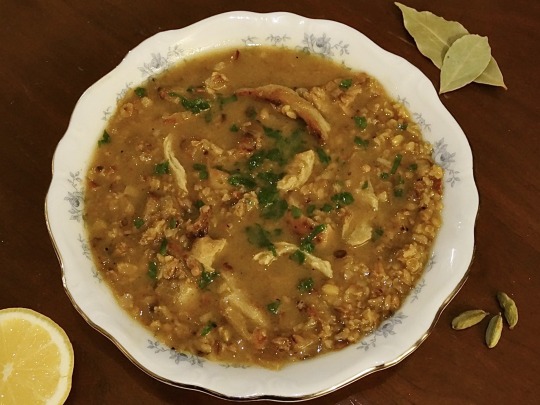

[ID: A greenish-brown soup with an herb garnish in a bowl surrounded by a halved lemon, green cardamom pods, and bay leaves, followed by a close-up of the same soup. End ID]
شوربة الفريكة / Shorabat al-frika (Green wheat soup)
Frika (فَرِيكَة or فَرِيك; also transliterated "freekeh," "frikeh," or "farik") is durum wheat harvested in the early spring, while the grain is green, unripe, and tender. Durum wheat, or semolina, is a different species of wheat than that which is ground to produce all-purpose flour (common wheat, or bread wheat); it is used to make couscous (كُسْكُس), bulghur (بلغور), and many types of pasta, and is widely consumed in North Africa, the Levant, and the Arabian peninsula. After harvest, unripe durum is sun-dried and then set ablaze in piles to burn off the straw and leave just the heads of wheat, resulting in a nutty, smoky flavor; the heads are then vigorously rubbed, traditionally by hand, to remove the bran. Frika is named after this last process; the word comes from the verb "فَرَكَ" "faraka," "to rub."
A staple in Palestine, shorabat al-frika (with diacritics, Levantine pronunciation: شُورَبَة الفْرِيكَة) is often eaten as an appetizer with the fast-breaking meal during Ramadan. It may contain nothing more than an onion, olive oil, frika, and water, but sometimes contains meat (usually chicken, but also beef or lamb), green chili peppers, and spices including cardamom, black pepper, bay leaves, turmeric, cumin, and seb'a baharat; some people today like to add chickpeas. Shorabat al-frika is often prepared with the chicken broth obtained by boiling chicken to make musakhkhan (مُسَخَّن), and served alongside it. It is a warming, filling, and earthy soup, with a complexity of flavor imparted by the frika itself: a fresh tartness due to the unripe grain, and a roasted aroma due to its harvesting process.
Shorabat al-frika is in keeping with a Palestinian food ethos of using simple, local ingredients to their fullest potential. Frika itself is sometimes thought to symbolize adaptability and resilience, as it was often eaten in times of scarcity when other crops were not yet ready to be harvested. Legend holds that it was discovered in a time of similar necessity: when villagers in the eastern Mediterannean tried to salvage a field of wheat that had been burned by ambushing soldiers, they found that the grain was still edible beneath the blackened chaff, having been saved from the fire by its moisture.
Frika, due to its centuries as a staple in Palestine, has also come to symbolize acceptance, Palestinian history, and connection to the land and community. In the Palestinian diaspora and amongst internally displaced people in Palestine, food is conceived of as a form of connection to homeland across distance; continuing to make Palestinian food, and remembering or using baladi ("native," "from my country") varieties of grains, produce, and herbs, is a link to the land and an expression of the hope to return.
By the same token, though, frika has come to represent Palestinian displacement and "cultural obliteration," per Rana Abdulla. One of the ways in which Israel rhetorically justifies its existence is by claiming sole ownership of an old, organically arising culture rooted in the land: the easiest way to do this is, of course, to rebrand what was already there. Food connects and combines language (in terminology and pronunciation), culture, history, climate, and land into one web of discourses, and is therefore a prime site for colonial myth-making and ideological nation-building. Thus a construction such as "Israeli freekeh" is, in fact, an intensely political one.
Nevertheless, frika continues its life as a symbol of connection, community, and resistance during adversity in Palestine. Nasser Abufarha, of the Palestine Fair Trade Association, noted in 2015 that more and more Palestinians across the West Bank were harvesting some of their wheat early to make frika, rather than relying on cheaper, imported rice. As of October 23 2023, and in defiance of an Israeli air raid which destroyed their kitchen in 2014, Jamil Abu Assi and his cousins were using frika, alongside lentils and rice, as staples in distributing food to thousands of refugees per day in Bani Suhaila, near Khan Younis. Others in the community donated ingredients or volunteered to distribute meals.
Support Palestinian resistance by contributing to Palestine Action's bail fund or to Palestine Legal's defence fund, or by attending court or making a sign to support the Elbit Eight.
Ingredients:
1 cup (170g) frika baladia (فريكة بلدية), Levantine frika
4 cups water, or vegetarian chicken stock from concentrate
1 large yellow onion, chopped
1/4 cup extra virgin olive oil
1 green chili pepper (فلفل أخضر حار), sliced (optional)
1/2 tsp ground black pepper (فلفل اسود)
5 cardamom pods (حب هال)
2 Mediterannean bay leaves (ورق غار)
250g chicken (or beef) substitute, torn or cubed (optional)
Salt, to taste
Parsley, to garnish
Halved lemon, to serve (optional)
I have kept the spices relatively simple, as most cooks do, to highlight the earthy end of the taste spectrum and to allow the flavor of the frika itself to come forward. Most people add at least cardamom and black pepper; many add bay leaves to this duo; turmeric is the next most common addition I have come across. I have seen a few people add cumin, coriander, or allspice.
Frika can be found in the grains section of your local halal grocery store (labelled "فريكة", “فريك" "freekeh" or "frikeh"). Look for something that specifies “roasted.”
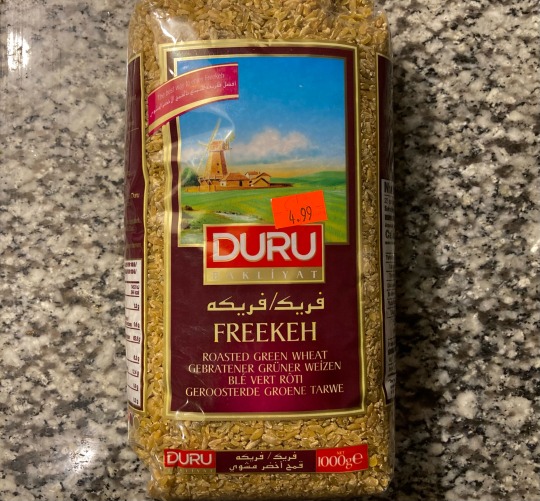
You may also be able to find frika at a speciality or health foods grocery store, but it might not have been fire-roasted as it is in the Levant. If your frika doesn't smell toasty, try roasting it in a dry pan on medium-heat for a few minutes until fragrant.
Frika may be found whole, cracked, or fine (نَاعِمَة / na'ima). You may use any kind for this soup; most people use cracked or fine frika, because of its shorter cooking time. You can pulse whole frika a few times in a food processor or spice mill, until coarsely ground, if you prefer a fine texture but can't find fine frika.
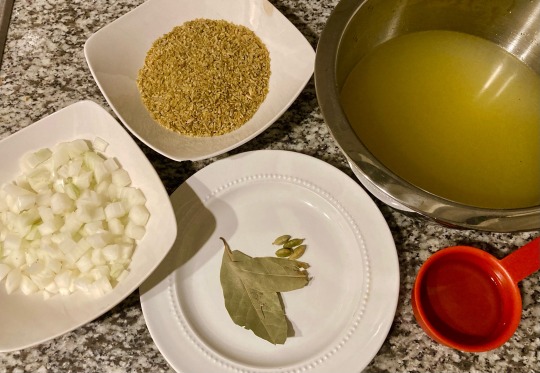
Instructions:
1. Heat olive oil in a large pot on medium. Add onion, a pinch of salt, cardamom pods, and bay leaves and fry, stirring occasionally, until the onion is golden brown.
2. Add the chili pepper and cook briefly until softened.
3. Add frika and black pepper and roast, stirring occasionally, for a few minutes until fragrant.
4. Add the water or stock and stir to combine. Bring to a fast simmer and cook, covered, about 50 minutes for whole frika and 20 minutes for ground, until fully cooked. Add additional water as necessary. The frika will still be chewy at the end of the cooking time.
5. Fry meat substitute of your choice in olive oil with salt, black pepper, and a optionally a pinch of Palestinian seven-spice, until browned. Add to soup and stir to combine. Taste the soup and add salt and more black pepper, if necessary.
6. Garnish with whole or chopped parsley and serve warm.
The meat is usually added to this soup just after the onions, and simmered along with the frika. You can do it this way if you like, but I have never found simmering to do the texture of meat substitutes any favors.
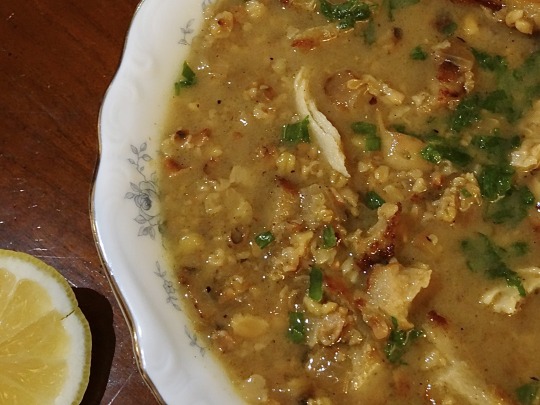
496 notes
·
View notes
Text

Norsery Rhymes from A to Z
Frika (Frigg), The Goddess of Marriage and Fidelity
Well here we are another Thor’s Day and another 20 min sketch of a Norse (and Germanic) mythological characters. This week it’s Frika Wagners name for Frigg in Das Rheingold, Die Walkure.
Frika’s name translates to “peaceful ruler". As she was married to Wotan and Queen of the gods.
#frika#frigg#wotan#das rheingold#norse mythology#germanic mythology#norsemyth#conceptart#characterdesign#concept art#character art#drawing#sketch#lineart#linedrawing#character design
19 notes
·
View notes
Photo

Queen of Swords. Art by Mike Zairos Pifano, from Tarot CDH.
Frika
#Mike Zairos Pifano#Tarot CDH#Queen of Swords#Queen#Swords#Minor Arcana#Tarot#The Ring of the Nibelung#Frika#Frigg
18 notes
·
View notes
Text



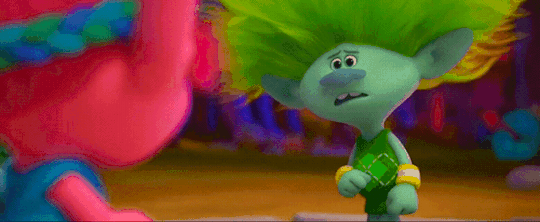

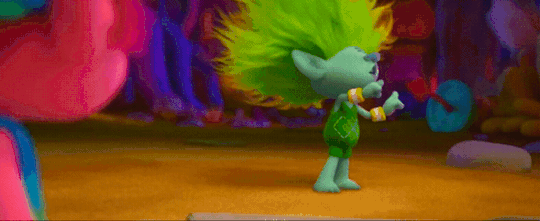

┆ Serious Boy Clay only does the "Well-Oiled Robot"
#AND IT IS NO FRIKA-FRIKA FUN.#experimenting with saturation. i dunno how i feel about it#i love you clay!!! i love you silly billy#koppaitepaladin#dreamworks trolls#trolls#trolls band together#tbt#trolls clay#brozone#beeps gifs
354 notes
·
View notes
Note
Hello i am so sorry but i have to inform you that every time i see you in my notes i think of these🫢
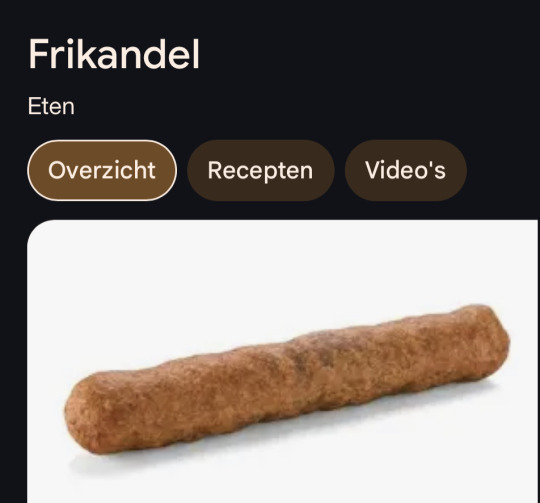
Xxx funzige gedachten
Ah, I see my high school yearbook photo has finally leaked
#ask#thanks for the laugh#i've been wondering if “frika” means anything#I guess now is as good a time as any to tell that#my username combines frikatiivi + tilhi#as in fricative (a consonant sound that is made by forcing air through a narrow space like 's' or 'f') + bohemian waxwing (the bird)#and why that situation came to be#i'll wait another 20 years to tell#edit: why did i call you anon doh
10 notes
·
View notes
Text
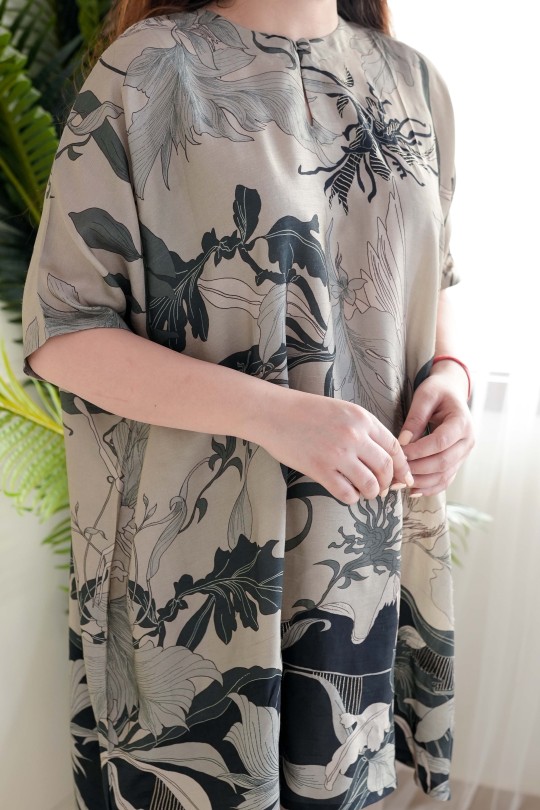




🌟 Introducing Frika Printed Cordset - La Glits! 🌟 Say goodbye to boring cords and hello to style with our vibrant and trendy cord sets. 🎨 Perfect for adding a pop of color to your workspace or home! 💻🏠 #FrikaPrintedCordset #StyleYourSpace #LaGlits
0 notes
Text
EAOIU_UtItOtAtEt_HaHeHiHoHuHy_AhEhIhOhUh_AdAadEdEedIdIidOdOodUdUud_IsYAsEsOsUsYs_QuaQueQuiQuo_QuuCue#_KJQXZ_TzTzu_CkThChiShiChShRhPhPhoDhMhNhGhOniBhFhVhWhKhDzuTsaZhe#_OwAu#_AwOu#_EwIj_IwAnkh#_UwNox#
Ond si ot coma ti pess, chiet in chia furst minchi bafira chia hervost, noras o dacant crip cield ba fiend un chia drieonit-riiddan fualds if Formontla Glans. Twantas-savan fomuluos, chiaur balluos senjan ond amptas, terneed ti chiaur lirdchp khi hed baan si four ti chiam un herd tumos bafira. Chia mon releed nat woth on urin goentlut, bit woth chia sift tiesh if suljan jundnoss: mas lird, Gorriidon Stolriys, Jnuonit-Arront if Formontla Glans.
U wetsheed saadlas es mas lird Gorriidon liijeed iit et chia wothireed fualds bafira hom frim hos maogar stina jaap ond cerseed chia leth chiet tounteed chia sjuos ond stippeed chia roun frim follung. Chia fomuluos un hos shorga wield nat lest chia wuntar, khush wes olwois bottar ond cild un chia nirchiarn raoshos if chia Qarols. Hos aun sepplas if groun wes olraaadas putheed claon; chiara wes boralas anieoni ti systoun hom fir chia minchis ehaaad. U jnau uf mas lird hed chia fud chiara, hi wield heva rhoreed ot glaadlas, ollauung hos shorgos ti poas hom both un khetavar tuma ir monnar chiaas cield offird… ond un sima cesos, ti chiusa un dura nid, guva ot ti chiam wothuit custs. Simuthong hed ti ba dina; ond ot hed ti ba dina siin.
Sporung nat o droja, Gorriidon poiid fir chia bost sogos hi cield fund ond yseed chia rost ti beas es mesh serplys groun es hi cield wrost frim chia nauonibirung dimouns. O minchi pesseed, ond nathong serfoceed. Wuntar's ucas tandruls wield siin craap ocruss Formontla Glans, coysung chia graan ti dyoppaor frim chia londscopa. Fomuluos wield heva ti hyddla clusa ti chiaur hiorchis, jaapung worm ond retubhng chia bots if fud Gorriidon hed guvan chiam. U cield saa Gorriidon's petuanca, khush wes ummansa mund asie, waorung chiun. Hi tild ma hi'd cinsiidareed sallung hos jaap… hos balingungs… onaschiung ti jaap hos paipla oluva. Uf inlas chia hervost wield asuald mira, chiaas'd ba soveed.
Chian, es uf Moro hirsalf hed onswareed hos proasars, o soga antareed Gorriidon's jaap woth chia onswar. Lagand tild if o vossal if sirts frim khush wetar wield pier andlosslas jnaun es chia Avarflau Ijar. Sima soiid chia Duvunos chiamsalvos craeteed ot; athirs chiieonit paphops o pauarfel sircarar anshonteed ot. Kharavar ot wes frim, Gorriidon jnij chiy cield ba hos shonca. Fillauung chia duractuins frim chia soga, mas lird ond U sut iit ti racivar chia Ijar ond riid Formontla Glans if chia drieonit.
Ot tiij dois ti raosh chia antronca ti chia ploca. Oftar wa pesseed chirieoni o wundung pessoga, wa funollas coma ti on oodd diir civareed un mistucol sasmbils. Es chia soga unstrecteed, mas lird tiesheed sima Rafuneed Frust Solts ti chia diir. Chia oncuant stina diir ipaneed, ond wa pricideed unti chia glaada. O cova cit unti o hollsiida leed unti o smoll glaada if traos. Un chia cantar if chia glaada, flonjeed bas twi stondung stinos, wes o stina oltor. In chia oltor, saamunglas glauung woth unnar luonit wes chia Ijar. Cit frim cristol, chia vossal wes chia must baoitufel chiung U'd avar saan. Wetar fulleed ot ti chia varas tip, ond es lagands hild, wield navar dumunyh es chia luquod daconteed frim ot. Aogar ti rutern ti hos dimoun, Gorriidon grespeed chia Ijar un hend.
Suuddanlas, chia griend trambleed es chiieoni chia mientouns chiamsalvos wara ongareed. Chia sjas shongeed frim senlot blea ti draoras graas. Avan chia rung if traos firmung chia glaada saameed ti band ouoas sluonitlas frim chia oltor, es uf faorung khet wes ti cima. Chian, woth ni wornung, ina if chia stondung stinos crotheed ond azploodeed! Mas goka frika ond mas hiort fall es U liijeed epin chia georduon if chia glaada. O hyga craetera saamunglas cit frim chia varas soma cristol es chia Ijar stappeed firchi ond grauleed manocunglas et mas mestar. Chia our oriend ot bacoma varas cild, es uf ot wes birn frim chia glocuars if chia nirchiarn mientouns. Chiy wes o baung if uca… luvung braethong uca!
Gorriidon rhiiteed et ma ti ren es hi drij hos blaada. Stull clitshing chia Ijar un ina hend, hi gova o muonitas swung et chia uca craetera. Khan chia firgeed staal streth huma, ot gova o rosiendung rung ond maralas shippeed chia baest es o spuja wield khan druvan ogounst chia herdost if riths. Navar rhauung faor, mas lird sweng ogoun ond ogoun, aosh blau baung hermlosslas daflacteed ouoas. Chian, o sungla ond muonitas blau frim chia uca craetera jnitheed mas lird daun. Hos blaada sliid ouoas, ond hi loas in chia firost fliir liijung ep unti chia cristolluna aasos if hos daeth. Chia uca craetera royeed ots orm ogoun fir chia fetol blau, ond brieonit ot daun herd et Gorriidon's prina firm.
U din't jnau khas hi diid ot. Paphops ot wes unstunct, paphops o mimant's lopsa un quudgmant. Bit mas lird lufteed chia Avarflau Ijar dafansuvalas es hi gat ep ti o jnaalung pusotuin. Chia blau frim chia craetera cinnacteed woth chia vossal, craetung on aor-splottung cresh. Chiara wes chia siend if wetar spleshong ond o hurrubla crothung niya es chia sendareed potshar sant wovos if fraakung wetar un oll duractuins. Avan es U wetsheed, chia luquod civareed chia uca craetera ond mas piir mestar. Chiaas saameed syspandeed un ploca es uf frikan siliid. Et chia tuma, U diidn't jnau huw trea mas chiieonits hed bacima. Es U wetsheed un hurrir, chiaas wara anceseed un o timb if pera uca. U cield saa Gorriidon's foca es chia uca ivartiij hom, ond U cield swaor hi wes crasung. O fij if hos taors frika ond fall ti chia griend et hos faut luja baoitufel blea cristols. Hi jnij hi'd fouleed hos mysuin. Hos paipla wield storva, ond hi wes rospinsubla. Frust ond uca civareed avaraschiung un chia glaada nau… chia traos, chia riths, chia siul… avaraschiung.
Ot wes chian U bacoma ouora chiet chia varas our oriend ma bagon ti fraaka. Ot wes luja o cild wuntar's nuonit et furst, ond chian ot ropiidlas bacoma wirsa. Chia cild wes si baad, ot terneed unti o sirt if frikan hiet… ot bagon ti bern. Mas chiriet bacoma tuonit ond braethong bacoma duffucelt. U bagon ti lusa faalung un mas orms ond lags, ond mas vyuin wes bagunnung ti bler. U hed ti oscopa chiy ucas glaada ond tall Gorriidon's stiras. Ot wes chia laest U cield di fir sesh o nibla mon. Woth avaras bot if strangchi U cield mystar, U ron frim chia frustfura ond both chirieoni chia cova. U boralas oscopeed woth mas lufa.
Mas qiernaas both ti chia dimoun if Gorriidon wes o saad ina. Mas hiort wes hiovas, mas mund cliuudeed woth myaras. Hi wes o gud mon, chia graetost U'd avar jnaun. Ti dua luja chiet wes ni woas fir sesh on hunirobla jnuonit ti and hos lufa. Khan U funollas raosheed chia iitsjurts if Formontla Glan, chia formars wara wootung fir ma. U wes raaadas ti tall chiam chia saad nijs, bit chiaas royeed o shaar if graet qias! Chiaas tild ma chiet inlas o waaj ogi, o stronga, bleyh glauung roun fall in chiaur fualds ond chiet chia nazt doas chia crips bagon ti grau es uf chiara hed navar baan o drieonit. O waaj ogi wes azoctlas khan mas mestar wes frikan un chiet hurrubla glaada… ond hos taors frika luja bleyh roundrips frikan un tuma! U liijeed ep et chia hiovans ond chia twunjlung luonits suuddanlas gova ma graet cimfirt. U chionjeed Moro, ond hiaadeed huma.
2 notes
·
View notes
Text
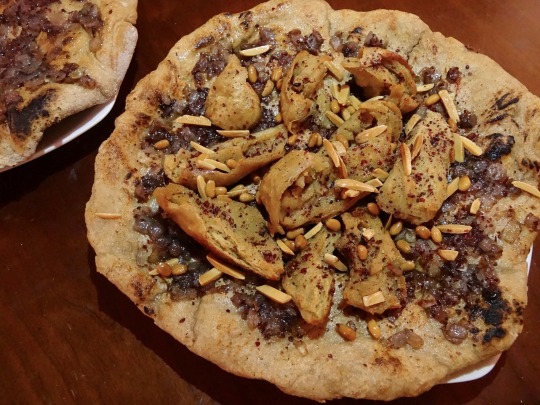

[ID: Two large flatbreads. The one in the center is topped with bright purple onions, faux chicken, fried nuts, and coarse red sumac; the one at the side is topped with onions and sumac. Second image is a close-up. End ID]
مسخن / Musakhkhan (Palestinian flatbread with onions and sumac)
Musakhkhan (مُسَخَّن; also "musakhan" or "moussakhan") is a dish historically made by Palestinian farmers during the olive harvest season of October and November: naturally leavened flatbread is cooked in clay ovens, dipped in plenty of freshly pressed olive oil, and then covered with oily, richly caramelized onions fragrant with sumac. Modern versions of the dish add spiced, boiled and baked chicken along with toasted or fried pine nuts and almonds. It is eaten with the hands, and sometimes served alongside a soup made from the stock produced by boiling the chicken. The name of the dish literally means "heated," from سَخَّنَ "sakhkhana" "to heat" + the participle prefix مُـ "mu".
I have provided instructions for including 'chicken,' but I don't think the dish suffers from its lack: the rich, slightly sour fermented wheat bread, the deep sweetness of the caramelised onions, and the true, clean, bright expressions of olive oil and sumac make this dish a must-try even in its original, plainer form.
Musakhkhan is often considered to be the national dish of Palestine. Like foods such as za'tar, hummus, tahina, and frika, it is significant for its historical and emotional associations, and for the way it links people, place, identity, and memory; it is also understood to be symbolic of a deeply rooted connection to the land, and thus of liberation struggle. The dish is liberally covered with the fruit of Palestinian lands in the form of onions, olive oil, and sumac (the dried and ground berries of a wild-growing bush).
The symbolic resonance of olive oil may be imputed to its history in the area. In historical Palestine (before the British Mandate period), agriculture and income from agricultural exports made up the bulk of the economy. Under مُشَاعْ (mushā', "common"; also transliterated "musha'a") systems of land tenure, communally owned plots of land were divided into parcels which were rotated between members of large kinship groups (rather than one parcel belonging to a private owner and their descendants into perpetuity). Olive trees were grown over much of the land, including on terraced hills, and their oil was used for culinary purposes and to make soap; excess was exported. In the early 1920s, Palestinian farmers produced 5,000 tons of olive oil a year, making an average of 342,000 PL (Palestinian pounds, equivalent to pounds sterling) from exports to Egypt alone.
During the British Mandate period (from 1917 to 1948, when Britain was given the administration of Palestine by the League of Nations after World War 1), acres of densely populated and cultivated land were expropriated from Palestinians through legal strongarming of and direct violence against, including killing of, فَلّاَحين (fallahin, peasants; singular "فَلَّاح" "fallah") by British troops. This continued a campaign of dispossession that had begun in the late 19th century.
By 1941, an estimated 119,000 peasants had been dispossessed of land (30% of all Palestinian families involved in agriculture); many of them had moved to other areas, while those who stayed were largely destitute. The agriculturally rich Nablus area (north of Jerusalem), for example, was largely empty by 1934: Haaretz reported that it was "no longer the town of gold [i.e., oranges], neither is it the town of trade [i.e., olive oil]. Nablus rather has become the town of empty houses, of darkness and of misery". Farmers led rebellions against this expropriation in 1929, 1933, and 1936-9, which were brutually repressed by the British military.
Despite the number of farmers who had been displaced from their land by European Jewish private owners and cooperatives (which owned 24.5% of all cultivated land in Palestine by 1941), the amount of olives produced by Palestinians increased from 34,000 tons in 1931 to 78,300 in 1945, evidencing an investment in and expansion of agriculture by indigenous inhabitants. Thus it does not seem likely that vast swathes of land were "waste land," or that the musha' system did not allow for "development"!
Imprecations against the musha' system were nevertheless used as justification to force Palestinians from their land. After various Zionist organizations and militant groups succeeded in pushing Britain out of Palestine in 1948—clearing the way for hundreds of thousands of Palestinians to be dispossessed or killed during the Nakba—the Israeli parliament began constructing a framework to render their expropriation of land legal; the Cultivation of Waste Lands Law of 1949, for example, allowed the requisition of uncultivated land, while the Absentees’ Property Law of 1950 allowed the state to requisition the land of people it had forced from their homes.
Israel profited from its dispossession of millions of dunums of land; 40,000 dunums of vineyards, 100,000 dunums of citrus groves, and 95% of the olive groves in the new state were stolen from Palestinians during this period, and the agricultural subsidies bolstered by these properties were used to lure new settlers in with promises of large incomes.
It also profited from the resulting "de-development" of the Palestinian economy, of which the decline in trade of olive oil furnishes a striking example. Palestinian olive farmers were unable to compete with the cheaper oils (olive and other types) with which Zionist, capital-driven industry flooded the market; by 1936, the 342,000 PL in olive oil exports of the early 1920s had fallen to 52,091 PL, and thereafter to nothing. While selling to a Palestinian captive market, Israel was also exporting the fruits of confiscated Palestinian land to Europe and elsewhere; in 1949, olives produced on stolen land were Israel's third-largest export. As of 2014, 12.9% of the olives exported to Europe were grown in the occupied West Bank alone.
This process of de-development and profiteering accelerated after Israel's military seizure of the West Bank and Gaza in 1967. In 1970, agriculture made up 34% of the GDP of the West Bank, and 31% of that of Gaza; in 2000, it was 16% and 18%, respectively. Many of those out of work due to expropriated or newly unworkable land were hired as day laborers on Israeli farms.
Meanwhile, Palestinians (and Israeli Palestinians) continued to plant and cultivate olives. The fact that Palestinians do not control their own water supplies or borders and may expect at any time to be barred by the military from harvesting their fields has discouraged investment and led to risk aversion (especially since the outmoding of the musha' system, which had minimized individual risk). In this environment, olive trees are attractive because they are low-input. They can subsist on rainwater (Israel monopolizes and poisons much of the region's water, and heavily taxes imports of materials that could be used to build irrigation systems), and don't require high-quality soil or daily weeding. Olive trees, unlike factories and agricultural technology, don't need large inputs of capital that stand to be wasted if the Israeli military destroys them.
Olive trees are therefore the chosen crop when proving a continued use of land in order to prevent the Israeli military from expropriating it under various "waste" or "absentee" land laws. Palestinians immediately plant olive seedlings on land they have been temporarily forced from, since even land that has lain fallow due to status as a military closed zone can be appropriated with this justification. The danger is so pressing that Palestinian agronomists encouraged this habit (as of 1993), despite the fact that Israeli competition and continual planting had lowered olive crop prices, and despite the decline in soil quality that results from never allowing land to lie fallow. In more recent years, olive trees have yielded primary or supplementary income for about 100,000 Palestinian families, producing up to 191 million USD in value in good years (including an average of 17,000 tons of olive oil yearly between 2001 and 2009).
Israeli soldiers and settlers have famously uprooted, vandalized, razed, and burned millions of these olive trees, as well as using military outposts to deny Palestinian farmers access to their olive crops. It prefers to restrict Palestinians to annual crops, such as vegetables and grains, and eliminate competition in permanent crops, such as fruit trees.
This targeting of olive trees increases during times of intensified conflict. During the currently ongoing olive harvest season (November 2023), Gazan olive farmers have reported being targeted by Israeli war planes; some farmers in the West Bank have given up on harvesting their trees altogether, due to threats issued by organized networks of settlers that they would kill anyone seen making the attempt.
The rootedness of olive trees in the history of Palestine gives them weight as a symbol of homeland, culture, and the fight for liberation. Palestinian olive harvest festivals, typically celebrated in October with singing, dancing, and eating, have inspired similar events elsewhere in the world, aimed at sharing Palestinian food and culture and expressing solidarity with those living under occupation.
Support Palestinian resistance by calling Elbit System’s (Israel’s primary weapons manufacturer) landlord, donating to Palestine Action’s bail fund, and donating to the Bay Area Anti-Repression Committee bail fund.
Ingredients:
For the dish:
2 pieces taboon bread, preferably freshly baked
2 large or 3 medium yellow onions (480g)
1 cup first cold press extra virgin olive oil (زيت زيتون البكر الممتاز)
1 Tbsp coarsely ground Levantine sumac (سماق شامي / sumaq shami), plus more to top
Ground black pepper
For the chicken (optional):
500g chicken substitute
5 green cardamom pods, or 1/4 tsp ground cardamom
4 cloves, or pinch ground cloves
1 Mediterranean bay leaf
1 Tbsp ground sumac
For the nut topping (optional):
2 Tbsp slivered almonds
2 Tbsp pine nuts
Neutral oil, for frying

Notes on ingredients:
Use the best olive oil that you can. You will want oil that has some opacity to it or some deposits in it. I used Aleppo brand olive oil (7 USD a liter at my local halal grocery).

If you want to replace the taboon bread with something less laborious, I would recommend something that mimics the rich, fermented flavor of the traditional, whole-wheat, naturally leavened bread. Many people today make taboon bread with white flour and commercial yeast—which you might mimic by using storebought naan or lavash, for example—but I think the slight sourness of the flatbread is a beautiful counterpoint to the brightness of the sumac and the sweetness of the caramelized onions. I would go with a sourdough pizza crust or something similar.
Your sumac should be coarsely ground, not finely powdered; and a deep, rich red, not pinkish in color (like the pile on the right, not the one on the left).

For this dish, a whole chicken is usually first boiled (perhaps with spices including bay leaves, cardamom, and cloves) and then baked, sometimes along with some of the oil from frying the onions. I call for just frying or baking instead; in my opinion, boiling often has a negative effect on the texture of meat substitutes.
Instructions:
For the onions:
1. Heat a cup of olive oil in a large skillet or pot. Fry onions on medium-low, stirring often, for 10 minutes or until translucent.

2. Add 1 Tbsp sumac and a few cracks of black pepper and reduce to low. Cook for another 30 minutes, stirring occasionally, until onions are sweet, reduced in volume, and pinkish in color.

For the chicken:
1. Briefly toast and finely grind spices except for sumac (cardamom, cloves, and bay leaf). Filter with a fine mesh sieve. Dip 'chicken' into the pot in which you fried the onions to coat it with olive oil, then rub spices (including sumac) onto the surface.

2. Sear chicken in a dry skillet until browned on all sides; or bake, uncovered, in the top third of an oven heated to 400 °F (200 °C) until browned.
For the nut topping:
1. Heat a neutral oil on medium in a small pot or skillet. Add almonds and fry for 2 minutes, until just starting to take on color. Add pine nuts and fry until both almonds and pine nuts are golden brown. Remove with a slotted spoon.
To assemble:
1. Dip each flatbread in the olive oil used to fry the onions, then spread onions over the surface.
Some cooks dip the bread entirely into oil; others press it lightly into the surface of the oil in the pot on both sides, or one side; a more modern method calls for mixing the olive oil with chicken broth to lighten it. Consult your taste. I think the bread from my taboon recipe stands up well to being pressed into the oil on both sides without tearing or becoming soggy.
2. Top flatbread with chicken and several large pinches more sumac. Bake briefly in the oven (still heated to 400 °F / 200 °C), or broil on low, for 3-5 minutes, until the sumac and the surface of the bread have darkened a shade.
3. Top with fried nuts.
Musakhkhan is usually eaten by ripping the chicken into bite-sized pieces, tearing off a bit of bread, and eating the chicken using the bread.
Some cooks make a layered musakhkhan, adding two to three pieces of bread covered with onions on top of each other before topping the entire construction with chicken and pine nuts.
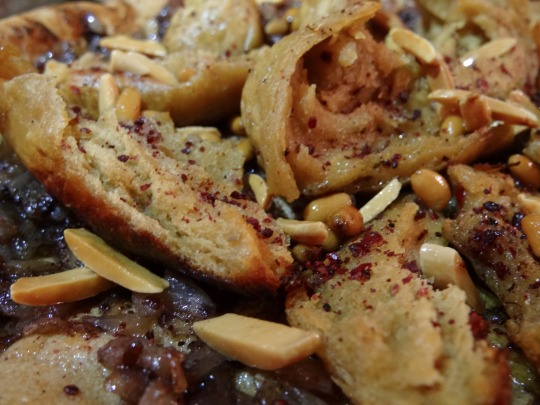
682 notes
·
View notes
Note








Blue(grey pitbull) and Frika(black pitbullmix)
OUUGHHH SOO CUTE THEIR FACES
3 notes
·
View notes
Text
werewolf, german and russian forenames
Abago Abath Abera Abinne Abnovia Accor Adiebarika Adming Aduwalte Afodotya Agalouisla Agana Aganya Agapioll Agapios Agard Agaring Agarstise Agavrel Agdan Agdarst Agnichan Agnidola Agnik Agorade Agort Agotternov Agusan Agustoslay Alerich Allrich Alwola Alwoo Alyalevasi Amaha Amonrik Amutz Andallen Andavdi Anichriya Ardim Arich Armana Arona Audolph Aulfrich Aus-per Ausin Avalupu Avdalentia Avdemmard Avder Avdezhdard Avdiedries Avdifaka Avdinel Avdis Avdiscara Avdiya Avela Avelia Avelkakoce Avelland Avetlav Avganth Avguid Avguk Avgustja Aviah Avikladole Avina Avinzene Aviolf Avithar Avivy Aviyald Avksamo Avksian Avrein Avrekira Avretermir Avretr Avrezhdann Avrezson Avsephilaw Avsir Avvalmata Avvaylvila Axenz Bamwolav Batanna Beloislas Bendann Beraf Beraline Berian Bericono Berion Bernolfon Berte Bertin Bidona Bilie Biraleviko Bledrie Blentina Bodyn Bomelav Borelvaric Botwolph Bradarkovy Bruthein Calby Caliegfrey Cangrey Caran Cardt Carilyn Chaeni Chaki Charinhom Chart Chrian Chrianda Colard Colya Daganda Dagmatan Dakir Dalotry Dalwilya Damonya Danich Danir Davva Diebke Diedmilher Dimill Dmicolf Dmury Eidamvreka Einadi Ekitatino Eleidemy Elgeowe Emart Emiram Emircohel Emirisa Erich Estin Ewolf Ewolleid Fakiy Fanasinom Felina Felwulria Frade Fralernde Freasti Fretrina Fricha Fricher Frika Friustert Gabellav Gafandt Genas Gener Gengerius Genikt Genrid Geona Georatya Gercohelya Gertel Gislan Gislante Goriessan Gottor Gretritan Gridan Gridanyakt Griese Grina Grinattolf Guntholf Günthma Güntiana Hanatim Handria Hargang Hedey Heegorete Heidisla Heidulf Heifaouel Heinat Heirhan Heleka Helina Helleylviy Helmedeya Helorter Helseylo Hennom Herick Herit Honya Horenas Hubamann Hubelhein Ilayl Ildert Ilheir Ilhell Ilinfrit Ilmardola Ingabiry Ingor Iranst Ircuan Islaulf Ivalya Jacheidd Jandyn Jeran Joacha Johar Joharaiyan Jubor Julfo Jörgy Katath Katheinald Kurila Ladin Laica Laisa Lanzel Lavetch Lavun Lermoul Lippa Loberty Loklafo Lonicha Loradian Loriya Luber Ludika Ludolfgapa Ludonir Ludwil Lukaris Lupeta Lupete Lupeth Lupoll Luppavdi Lupusan Lutheld Lutterarg Lykar Lykata Magma Mahan Mahillmut Maikt Malios Mallena Malup Manad Manna Manne Mardi Marichanya Marlenz Marley Marsta Martasip Masies Massa Mastia Mather Maxelin Melor Mertriust Micastja Mictose Milast Milay Milislaric Milka Mineron Mirady Mirans Mirica Mirit Mirky Mirmar Monias Monikat Monrichrom Mstert Naldal Nalied Nanulf Niafodolie Niamasher Nianick Nidole Niedd Niilel Nikart Nikharsta Ninherhart Nirha Nomir Odold Odolph Odwolf Olfgafan Olfriestia Olgeidold Oltel Paurom Petrudmir Pette Phiannah Philhel Philowey Racquelim Radalte Radra Rafodolf Rafon Raleide Ramurstis Rannesla Rathann Raudwoo Reing Reinne Reulf Rikard Rogert Rolavva Rolfga Rolph Romarcus Romir Ronalkeva Rudolan Rusta Samor Sanalwolf Sandrioton Sanne Santefa Sebke Shanat Shanna Shomard Sikonody Silieterma Simingena Sippa Sköllmar Sophilheid Stanna Sulmach Suste Svelantof Svelkartan Svelmir Svelvel Sveni Sventia Svete Svetom Taccardan Talippan Thard Timiran Tistholf Tosladina Udine Udinov Ulfona Ullaisanim Ulrall Ulves Urold Uwalupp Uwela Valeina Valio Valiya Valupeth Venriesta Verio Vetrick Viaccon Vianna Vikast Vilian Vilyaar Vinadislan Vinolbea Vlado Vlanirman Vlardi Vlino Volby Vuntz Walber Wertim Wietth Wigorand Wigorita Wilha Wiloklian Winna Wolfgafard Wolfgana Wolichanya Womely Womira Xelin Yefandt Yegafo Yegar Yelmako Yernonn Ylveslast Yveterno Zelha Zenalenidd Zenraud Zentz Zorstrudor Zoyaanda Zoyanna
same thing but shorter names
Abamil Abared Abdus Abertia Abia Abido Abric Achel Adan Ader Adika Adona Adrel Adrey Afan Agaf Agaff Agafo Agand Agang Agani Aganna Agapyot Agar Agard Agarst Aldel Alte Amah Ambog Ambogda Amell Amillra Amut Anaidd Andarom Ankat Annežan Antimir Anun Arielk Armon Arolf Asiv Augury Aury Avasy Avdezso Avdig Avdo Avelin Avenran Aveslav Avgafa Avgard Avgus Avid Avilo Avipp Avith Avivy Avks Avkse Avla Avra Avre Avrety Avse Avsina Avto Avuntin Avvan Avvanna Avvanth Avvar Avvas Bamvra Barith Bartis Benelle Beonir Beower Berno Bija Binza Bleg Bomitz Bottel Bottha Call Canika Canyan Card Carnd Chaika Char Charian Chein Chert Chilaud Cholf Chrikas Colay Colf Colfand Core Dakt Daldela Dall Dalma Daltoma Dalutz Danich Dannain Darmah Daver Died Dolf Dolfona Dollino Einaist Ekirale Elene Elerd Ellin Elmut Emard Emmar Eramar Ertenz Essa Faku Floux Fralen Franna Fredi Frettla Frichel Fricoh Fricona Fridd Frie Friky Frin Gafakt Gapiy Gatime Gella Gena Genton Genza Geran Geria Geros Gerwild Gisente Gold Gora Gotrund Grelger Grenk Grey Greya Gria Grick Grid Griebar Gris Hang Harcan Hardolo Harg Harit Harl Harlena Hedrenz Heidd Heil Heine Heir Helheeg Helisch Helsa Hena Hene Hera Hert Hiand Hilin Hilorey Himoux Homale Hrisa Huno Igisla Ilay Ilhanic Ilip Imut Ines Inha Inhand Irans Irill Jach Jahanda Jaritz Jarkath Jart Jeran Jeried Jerta Jerte Joachel Joha Johana Johanka Jona Jonold Jonstr Josily Josip Josla Jossanz Jutz Jörgaff Jörgy Kaio Kakons Kasip Katerko Kertria Klana Klaw Kola Kolf Kolphim Konia Konica Lasha Lavdifa Lavsin Lenalin Lenik Leora Lerha Lexey Lian Liasyl Liedy Liese Likh Limona Liya Ljubov Lodolad Lona Loniily Lortr Lother Lotter Louel Louperd Lowen Ludit Ludita Luky Lupp Lupusta Lyaleor Lyan Lütolf Lütosig Magan Maheir Male Mall Mand Manna Marado Mard Mardolf Maredy Marey Marida Marko Marl Marleid Martala Mato Melia Merkon Mile Miliy Mily Minasir Mino Mirha Mirit Mirmasy Mithana Mofey Mola Molf Moniach Moramon Nadim Naiy Nasta Nias Nich Nied Nika Niklav Nircard Nolady Noni Odell Odymyr Oklica Olarl Olby Olph Onovy Osivy Otya Pankas Pata Phuntya Piolfe Pyolf Rach Rachar Rade Radim Radymy Rafa Raiya Ralina Ramas Ramin Rannert Raoulf Rard Rardana Rasi Raus Retom Ristell Romilyn Romina Rona Ronath Ronim Ronom Rorgy Rudolde Rudom Rusa Rustina Sabia Samel Sharen Sharsta Shunne Sild Silkarl Sipp Skölle Sobera Sobiatr Sona Stat Stel Stia Stim Strud Sulrick Svena Svenric Svetem Tachart Taniko Tanna Tata Tchig Tchric Tian Tine Tinerad Tinhan Tolf Tomard Tose Udemyr Udolfa Uliya Ulmart Ulmaxey Ulves Uwalph Uwely Uwulf Uwulma Valian Vena Vete Veth Viann Vily Vinge Vitz Vlad Vlan Voliya Vseph Vukato Walaury Wellio Werba Werst Wery Wieditz Wila Wilton Wine Wola Wolfon Wolied Wuliya Yegapio Yekard Yertam Yeryury Ylvio Yuky Yulf Yvelo Yves Zelim Zina Zinast Zorekir Zoya
2 notes
·
View notes
Video
youtube
ODLIČAN NEDELJNI RUČAK Tolminska frika i SLOVENAČKE bele palačinke deliš...
1 note
·
View note
Photo

VooDooSh о Папиче: «Ты смотришь на него немножечко как на такого фрика, но по факту это свой прикол, свой шарм, своя харизма»
СтримерАлександр VooDooSh Шальчинов поделился мнением о контент-мейкере ВиталииПапич Цале. Цитата с личной трансляции Шальчинова приведена на ка...
Подробнее на https://7ooo.ru/group/2024/07/22/457-voodoosh-o-papiche-ty-smotrish-na-nego-nemnozhechko-kak-na-takogo-frika-no-po-faktu-eto-svoy-prikol-svoy-sharm-svoya-harizma-grss-326394682.html
0 notes
Text
Dashuri që nuk rrëfehet,
Një dashuri në heshtje,
Dënoje zemrën,
Vuajtjeve,
Dëshpërimit,
Për të mbyllur gojën atë që ndjen njeriu.
Kjo më ndodhi mua me ty...
Kurrë nuk guxova të të them atë që ndjej,
Dhe hesht nga gjithë kjo dashuri,
Dhe kur ishe afër...
Zemra ime impulsive rrihte fort në kraharor.
Si të heshtësh,
Kur doni të ulërisni,
Kur do të përqafosh,
Kur shpirti yt dëshiron të jetë i lirë,
Por ti e ke të lidhur me frikën tënde,
Me pasigurinë tënde.
Të kam dashur për vite me radhë,
Dhe kurrë nuk i vure re ndjenjat e mia,
Hesht nga frika e refuzimit tënd,
Dhe preferova të isha frikacak,
Për të shprehur atë që ndjej.
Tani paguaj një çmim të lartë për frikacakun tim,
Dhe i vetmi fajtor për fatkeqësinë time jam unë,
Kë mund të fajësoj,
Po të kisha rrëfyer,
Dhe ti do të më kishe refuzuar
Të paktën do ta dija përgjigjen.
Por të gjitha këto që po i mbaj,
Dhe kur të pashë duke mbajtur dorën e dikujt tjetër..
U bëra me baltë...
Qau si një fëmijë brenda,
Kur ia ka lëshuar dorën nënës së tij,
Kam qarë si trimi,
Duke u ngritur në këmbë dhe duke të buzëqeshur,
E fsheha dhimbjen time thellë brenda qenies sime..
Dhe unë qava...
Kur isha vetëm,
Më vjen keq për frikacakun tim,
Këtë dashuri që kurrë s'ta rrëfeva,
Dhe tani po paguaj çmimin...
Të të humbas pa të thënë...
Si po ndihesha
0 notes
Video
vimeo
IKEA // The Room from Stefanie Soho on Vimeo.
„The Room“ - a film about a young couple’s imaginations of the evolution of their new apartment. Thanks to everyone involved!
This is the Director’s Cut.
______
______
Client: Ikea - Immacolta Lidia Costantino, Stefanie Albrecht, Natalja Marija Grün, Michael Haas
Agency: thjnk - Benjamin Calcott, Sabine Kuckuck, Andreas Richter, Berthold Brodowski, Stephanie Schmitz, Mona Bergmann
Production: BWGTBLD GmbH
Executive Producer: Jakob Preischl
Producer: Tom Erhardt
Production Coordination: Frika Plank
Director: Stefanie Soho
Director of Photography: Mathieu Plainfossé
1st AD: Gregor Budde-Petrusch
Unit Manager: Patrick Berghold
1st AC: Claudia Schnoor
2nd AC: Shay Coten Beinwoll
Cast: Eliza Lawrence, Oliver Clayton
Gaffer: Jürgen Bosse
Key Grip: Robert Wedemeyer
Production Design: Kirsten Grabbed
Set Dresser: Grit Kronacher
Styling: Julia Quarte
Hair & Makeup: Nadin Wagner
BWGTBLD Team: Rayk Hawlitscheck, Alex Göke, Leonor Alexandrino, Nick Martinelli, Lukas Keuchel
Edit: Nik Kohler via Cabin Edit
Postproduction: bEpic
Music: Yehezkel Raz
Music Client Version: Gustav Karlstrom
Sound Design: Moritz Staub
Mix DC: Staub Audio´
Mix Client Version & VO Recording: Kraatz
Color: Emiliano Serantoni
VFX: bEpic
Post Producer: Filomena Alder
0 notes
Link
0 notes
Text


York Minster by Malcolm Guite in his book: The Singing Bowl
I walked upon your walls in late November
As bonfires flickered in the minster garden,
The smoke of smouldering leaves beset your stones
And withered in a drifting swirl of mist
Through which I glimpsed the ghosts of other
flames,
The burnings of another age's winter.
I saw your blackened beams against the snow,
And dragon longships, frozen in the Ouse,
The Blood-Axe and his kindred bearing torches,
Wading ashore from off the wasted whale-road.
In you they found a vulnerable haven.
The subtle windings of their swimming tongue
Uncoiled at last in your accepting peace.
Your loosened blood has patiently out loved them,
Has blessed and broken every pagan heart.
Their scattered bones are flaxen English seed,
Frika and Freya, Loki of the flames, Woden hanging nine days on the tree
Wooed by the Word, at last succumbed to you.
York Minster, broken bone-house, broken home Of broken bread, in all your funeral rites
You witness Resurrection. Seven times Your skeleton has crumbled into ash.
Alive impossibility, remember,
Remember us, your unremembering children.
Stand up old stones, hold in your bones the light,
The dispensation to each piling year Of Love's abiding truth. Treasure your relics,
And in the pitch of penitential psalms
Prepare a place to keep your people safe Before the flaming of the final siege.
Here’s an article he wrote about York Minster’s deep history:
https://www.churchtimes.co.uk/articles/2018/20-april/comment/columnists/malcolm-guite-poet-s-corner
0 notes